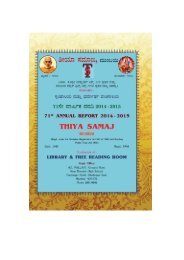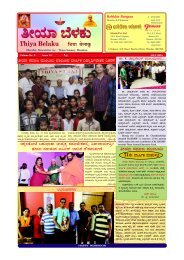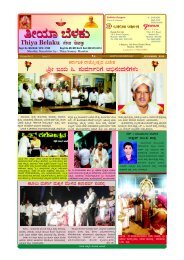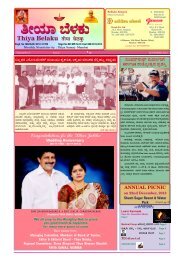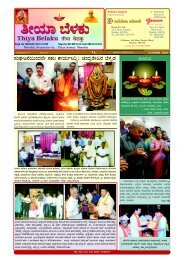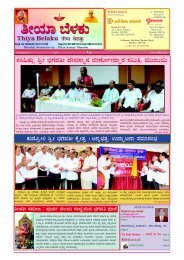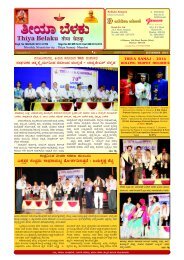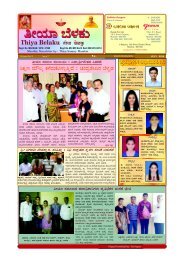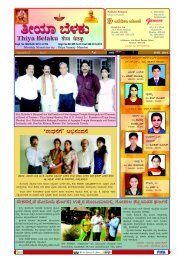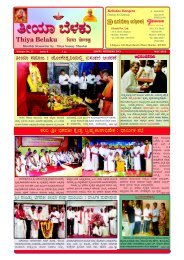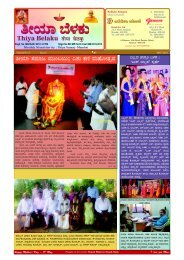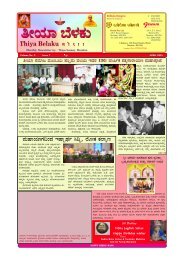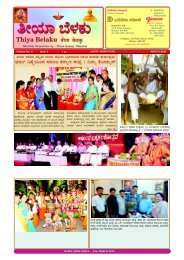Thiya Belaku - June 2015
You also want an ePaper? Increase the reach of your titles
YUMPU automatically turns print PDFs into web optimized ePapers that Google loves.
=jûK 2<br />
At the outset let me congratulate to all our <strong>Thiya</strong> students who<br />
topped this year too in the board examinations. You childrens<br />
makes us feel proud.<br />
The last month was filled with the aroma of Mother's<br />
unconditional love n unconditiinal care. Even as this editorial is<br />
being written to backed Mother India's call to observe International<br />
Yoga Day. About 130 countries, including the USA, Canada and<br />
China, have signed for a co-sponsorship of a draft resolution which<br />
India's UN mission is preparing for declaring <strong>June</strong> 21st as the<br />
International Day of Yoga.<br />
Ah, the joys of physical education. Most students are able to<br />
look back fondly on days spent running around the track, climbing<br />
on malkaam bars and playing football with their friends. Some<br />
schools even go out of their way to provide students with exposure<br />
to obscure niche sports like volley ball, badminton and basket ball.<br />
But one activity that has remained absent from schools for far too<br />
long is also one of the most significant and beneficial—the art of<br />
Yoga.<br />
‘Yoga’ is a term that encompasses a wide range of techniques<br />
including breathing exercises, meditation and the mastery of<br />
specific bodily poses. These practices, when combined, form a<br />
discipline that is intensely physical, spiritual and mentally stimulating.<br />
Unfortunately, yoga is often-times thought of more as a punch line<br />
than as a legitimate exercise. It frequently gets written off as just<br />
another example of new-age quackery, and this could not be<br />
further from the truth. On the contrary, yoga is actually one of the<br />
oldest and most storied practices in human history.<br />
Yoga is believed to have originated in the Indus River Valley,<br />
around four or five thousand years ago. In the centuries that<br />
followed, the art would grow to become a central part of Vedic<br />
culture, the primary inhabitants of India at the time, before spreading<br />
to nearby regions like China and Vietnam. Religions of the area like<br />
Jainism, Hinduism, and Buddhism began using yoga in their<br />
religious ceremonies and rituals, because they believed it to be a<br />
tool for achieving enlightenment.<br />
Yoga’s association with religion has actually been one of the<br />
major roadblocks it has faced in being introduced to public schools.<br />
In California, a 2013 lawsuit by the National Center for Law & Policy<br />
attempted to bar yoga from being practiced in a local elementary<br />
school, claiming that it was an unlawful crossover between church<br />
and state. By practicing yoga, they asserted, children were being<br />
forced to learn about and adhere to Eastern religions. The lawsuit<br />
failed after the school was able to successfully argue that yoga was<br />
being practiced solely for its physical benefits, but only after they<br />
had eliminated several Hindu elements from its practice, including<br />
the discontinuance of several poses said to represent the worship<br />
of Hindu deities, as well as the removal of several posters containing<br />
Sanskrit, the holy language of Hinduism.<br />
However, it should be of little surprise that they were able to<br />
argue yoga’s health benefits, due to the sheer number of them.<br />
Scientific studies have revealed countless other obscure health<br />
benefits, including, but not limited to: boosting your immune<br />
system, aiding in weight-loss, strengthening bones, increasing<br />
blood flow, and reducing the risk of diabetes and cancer. For an art<br />
that emphasizes remaining calm and relaxed throughout its practice,<br />
it can actually be incredibly strenuous—holding and transitioning<br />
between poses requires an immense amount of coordination,<br />
flexibility, and muscular strength, in a way that students may not be<br />
used to.<br />
The art is just as much mental as it is physical. Yoga requires<br />
practitioners to remain calm and focused throughout its practice,<br />
even while holding complex and physically demanding positions.<br />
Relaxation is also a major focus of the art, and part of the reason<br />
why it is such an effective stress reliever. For students feeling<br />
overwhelmed by homework and other responsibilities, yoga can be<br />
extremely useful in helping them cope.<br />
All in all, there are many reasons for schools to include yoga in<br />
their physical education programs. It is accessible to students of all<br />
fitness levels, and its practice will help them build muscular<br />
strength, improve flexibility, reduce stress, along with countless<br />
other benefits to their health. And contrary to popular belief, its<br />
practice does not require a religious element to be effective. While<br />
it’s a good sign that yoga is already being included as part of<br />
existing aerobics and weight-training classes.<br />
It is clearly the cultural impact of Indian life that has led to the<br />
eco-friendly habits of the Indians. This in turn has to be related to<br />
the core yoga values that form the Indian cultural and social lifenamely<br />
moderation in consumption and self-reliance rather than<br />
looking for external sources.<br />
I really do hope to see yoga with a class of its own difference.<br />
- Sridhar S. Suvarna<br />
Editor-in-Chief<br />
THIYA BELAKU<br />
...............................................<br />
Editor :<br />
Sridhar S. Suvarna<br />
M. 808090 4895<br />
Jt. Editor :<br />
Krishnappa Billawa<br />
Advisory Board :<br />
Rohidas Bangera<br />
Ail Babu<br />
Hema Sadanand Amin<br />
Narayan Salian<br />
Sadashiva B.K.<br />
Narayana Suvarna<br />
Finance :<br />
Sunder Ail<br />
Mohan B.M.<br />
Advertising :<br />
Thimmappa Bangera<br />
Purandar Salian<br />
Taranath Karkera<br />
Mangalore Rep:<br />
Premchand<br />
Vaman Idya<br />
Rohini B.M.<br />
Rajendra Prasad Kateel<br />
Udupi Rep.:<br />
Umanath Kaup<br />
Kasargod Rep.:<br />
Vasudev Uppala<br />
Haridas Bolar, Kumbla<br />
Bhaskar Kasargod<br />
Publisher :<br />
Chandrashekar B.<br />
Co-ordinating Office :<br />
<strong>Thiya</strong> Samaj, 4 ‘Pallavi’,<br />
Pant Nagar North,<br />
Ghatkopar (E),<br />
Mumbai - 400 075.<br />
Tel.: 2501 6092<br />
<strong>Thiya</strong> <strong>Belaku</strong><br />
SB A/c. 000510100248197<br />
The Bharat Co-op. Bank<br />
(Mumbai) Ltd.,<br />
Mulund (East) Branch<br />
IFSC code : BCBM0000006<br />
E-mail: thiyasridhar@rediffmail.com<br />
Word Press (pdf file) :<br />
<strong>Thiya</strong>jyoti.wordpress.com<br />
www.thiyasamaj.com<br />
aBu|Cj DjrÖj




